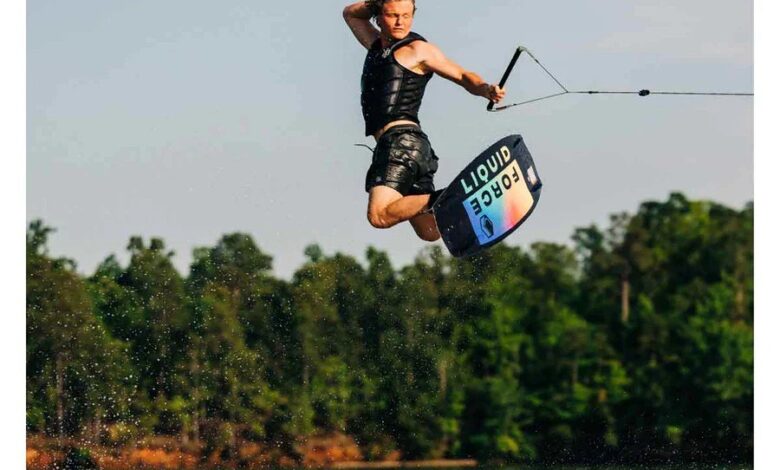Taming the Tide: The Thrill of Wakeboarding

Wakeboarding is more than just a sport—it’s an experience that combines the forces of nature with the rider’s skill, power, and creativity. As one of the most exhilarating water sports, wakeboarding allows individuals to glide across the water’s surface, perform gravity-defying stunts, and feel the surge of adrenaline that comes from mastering the tides. The sensation of riding the wake, launching into the air, and conquering the water offers an unparalleled blend of thrill and artistry.
In this article, we’ll explore the journey of taming the tide through wakeboarding. From the foundational techniques to advanced stunts, and from the mental preparation required to overcome fear, to the culture that surrounds the sport, we will dive into the essence of what makes wakeboarding such an enticing challenge for water sports enthusiasts.
A Brief Introduction to Wakeboarding
Wakeboarding combines elements of surfing, snowboarding, and waterskiing into one dynamic sport. It involves being towed behind a boat (or a cable system) while riding a specially designed board. The goal is to use the wake created by the boat as a ramp to perform tricks, jumps, and spins.
Wakeboarding requires both physical and mental strength. The rider must balance on the board, maintain control of their speed and direction, and utilize the boat’s wake to perform tricks. At its core, wakeboard is about harnessing the power of the water and using it to fuel your creativity and skill.
The Foundation of Wakeboarding: Building Your Skills
Before riders can experience the thrill of advanced tricks and aerial stunts, they must first master the basics. Understanding the fundamentals of wakeboarding is essential for developing the confidence and control needed to progress to more challenging maneuvers.
1. Getting Started: Equipment Essentials
Wakeboarding requires a few key pieces of equipment:
- Wakeboard: The board is designed with fins and a rocker (the curve of the board) to allow for stability and control. Boards come in various sizes and shapes, depending on the rider’s skill level and style.
- Bindings: These are the boots attached to the board, which secure the rider’s feet. A good pair of bindings provides support and ensures that the rider maintains control during tricks.
- Tow Rope: The tow rope connects the rider to the boat, providing the necessary pull. It’s important to use a wakeboarding-specific rope that doesn’t stretch, ensuring a consistent pull.
- Life Jacket and Helmet: Safety is critical in wakeboarding, and wearing a life jacket ensures buoyancy and protection in the event of a fall. A helmet, while optional in some cases, is recommended, especially when attempting advanced tricks or riding in obstacle-laden areas.
2. Mastering the Basics: Your First Ride
Getting up on the wakeboard for the first time can be daunting, but with the right technique, it becomes a smooth process. Here’s a step-by-step breakdown of how to get up on the board:
- Starting Position: While in the water, position the board perpendicular to the boat with your knees bent and your arms extended, holding the tow rope handle. Keep your back straight and focus on staying relaxed.
- The Pull: As the boat begins to move, allow the boat’s pull to gradually lift you. Avoid pulling yourself up; instead, let the boat do the work. Your job is to maintain balance and keep your knees bent.
- Standing Up: As the boat pulls you forward, slowly stand by straightening your legs. Keep your arms extended and your weight evenly distributed between your front and back foot. This ensures stability as you begin to ride.
- Riding Position: Once standing, focus on keeping your body relaxed, knees slightly bent, and your weight centered over the board. Avoid leaning too far forward or back, as this can cause you to lose balance.
3. Turning and Edging
After mastering the basics of getting up and riding, the next skill to develop is controlling your direction. This involves learning how to turn and edge on the board:
- Heel-Side Turn: To initiate a heel-side turn, shift your weight slightly onto your heels. This will cause the board to pivot and move in the desired direction. The key is to maintain balance and avoid over-leaning.
- Toe-Side Turn: A toe-side turn involves shifting your weight onto your toes. This turn is more challenging because it requires greater control, but with practice, it becomes easier to execute.
- Edging: Edging is the technique of riding on the edge of the board, which helps generate speed and prepares you for jumps. When edging, lean into your heels or toes to carve a path through the water, which builds tension in the rope and propels you forward.
Riding the Wake: Pushing the Limits of Wakeboarding
Once the foundational skills are in place, riders can begin to experiment with the more advanced aspects of wakeboarding—namely, using the wake as a ramp to perform jumps and tricks. This is where wakeboarding truly begins to push the boundaries of what’s possible on the water.
1. Approaching the Wake
The key to any trick in wakeboarding is mastering your approach to the wake. The wake acts as a ramp that allows riders to launch into the air. Here’s how to approach the wake for maximum effect:
- Building Speed: Before hitting the wake, edge away from the boat to build speed. The more tension you create in the rope, the higher you’ll be able to jump.
- Controlled Approach: As you approach the wake, shift your weight to the center of the board and maintain a balanced stance. Avoid leaning too far forward or back, as this can throw off your jump.
- Timing the Pop: The “pop” refers to the moment when you push off the wake to launch into the air. To generate a strong pop, push down with your back foot just as you reach the peak of the wake. This will give you the lift needed to perform jumps and tricks.
2. Basic Tricks and Jumps
Once you’re comfortable with jumping off the wake, you can start experimenting with basic tricks:
- Ollie: The ollie is a fundamental trick that involves popping the board off the water without using the wake. This trick is often the starting point for more advanced jumps and aerials.
- Grab: A grab adds style to your jump by reaching down and grabbing the board while in the air. There are various types of grabs, depending on which part of the board you grab.
- 180 Spins: This trick involves rotating the board 180 degrees in the air before landing. A frontside 180 spins the board forward, while a backside 180 spins it in reverse. Spins are an excellent way to start building rotational control for more advanced tricks.
3. Pushing Boundaries: Advanced Tricks
As riders gain confidence and control, they can begin to push the limits with more advanced tricks:
- Inverts: Inverts are tricks that involve flipping the board while airborne. Common inverts include backflips and tantrums, where riders flip backward over the wake. Inverts require a strong pop off the wake and excellent body control to execute.
- 360 and 540 Spins: Spins of 360 degrees or more add a level of complexity and difficulty to wakeboarding. These tricks require precise timing and balance, as the rider must rotate fully before landing.
- Handle Passes: Some tricks involve passing the tow rope from one hand to the other while in the air. This adds complexity to spins and flips, requiring focus, timing, and agility.
Overcoming Mental and Physical Challenges
Wakeboarding is as much a mental game as it is a physical challenge. Overcoming fear and building confidence are crucial steps in mastering the sport. Here’s how to tackle some of the most common mental and physical challenges in wakeboarding:
1. Fear of Falling
Falling is inevitable in wakeboarding, especially when learning new tricks. The key to overcoming the fear of falling is to embrace it as part of the learning process. By gradually building up your skills and pushing your comfort zone, you’ll become more confident and less fearful of failure.
2. Physical Conditioning
Wakeboarding requires strength, endurance, and flexibility. Riders must have strong core muscles for balance, powerful legs for jumping, and a flexible body to perform aerial maneuvers. Regular exercise, including strength training, cardio, and stretching, is essential for staying in peak wakeboarding condition.
3. Persistence and Patience
Mastering wakeboarding takes time and persistence. Progress can be slow, especially when learning advanced tricks, but patience is key. Celebrate small victories along the way and keep pushing yourself to improve.
The Wakeboarding Culture: A Community of Thrill-Seekers
Wakeboarding is more than just an individual pursuit—it’s also a vibrant community of passionate riders. Whether at a local lake or at international competitions, wakeboarders are known for their camaraderie, support, and shared love of the sport.
- Local Communities: Many wakeboarders join local clubs or groups to practice together, share tips, and celebrate each other’s progress. These communities often organize events, clinics, and competitions, providing opportunities for riders to learn from each other and grow.
- Events and Competitions: Wakeboarding competitions, both local and international, push the limits of the sport. Riders showcase their skills, creativity, and athleticism while competing for recognition and prizes. These events are a great way to witness the cutting edge of wakeboarding and get inspired.
Conclusion: The Thrill of Taming the Tide
Wakeboarding is an exhilarating sport that combines skill, creativity, and a fearless attitude. From mastering the basics of riding and turning to pushing the limits with advanced tricks and spins, wakeboarding offers endless opportunities for thrill and self-expression. Whether you’re a beginner testing the waters or an experienced rider defying gravity, the journey of taming the tide is as rewarding as it is exciting.




